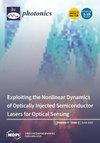设计用于激光吸收光谱的长光路直接注入式集成腔体
IF 1.9
4区 物理与天体物理
Q2 OPTICS
引用次数: 0
摘要
痕量气体测量在工业、医疗和环境保护领域有着广泛的应用。随着时代的发展,人们对气体检测的实时性、灵敏度和准确性的要求越来越高。离轴集成腔输出光谱(OA-ICOS)是一种高灵敏度检测痕量气体的有效方法。它使用带有两个高反射镜的集成腔来提供长光路,从而保证了其高灵敏度。然而,随着反射镜反射率的增加,输出光的强度降低,信噪比也随之降低。这一矛盾使得长光路和高信噪比难以同时实现。针对这一问题,本文提出了一种采用直接注入法的集成腔。这种结构在等效镜面条件下,能保持与原离轴集成腔非常接近的有效吸收光路,同时将输出光强度提高数百倍。这种改进提高了 OA-ICOS 的灵敏度。本文章由计算机程序翻译,如有差异,请以英文原文为准。
Designing a Long Optical Path Direct-Injection-Integrated Cavity for Laser Absorption Spectroscopy
Trace gas measurement has a wide range of applications needed in industrial, medical, and environmental protection. With the evolution of time, the demand for real-time, sensitivity, and accuracy of gas detection has been increasingly heightened. Off-axis integrated cavity output spectroscopy (OA-ICOS) is an effective method for the high-sensitivity detection of trace gases. It uses an integrated cavity with two highly reflective mirrors to provide a long optical path, which guarantees its high sensitivity. However, as the reflectivity of the mirrors increases, the intensity of the output light decreases, and the signal-to-noise ratio decreases. This contradiction makes it difficult to achieve a long optical path and a high signal-to-noise ratio together. To combat this issue, this paper proposes a type of integrated cavity using a direct-injection method. This structure, under equivalent mirror conditions, can maintain an effective absorption optical path very close to the original off-axis integrated cavity while increasing the output light intensity hundreds of times. This enhancement increases the sensitivity of OA-ICOS.
求助全文
通过发布文献求助,成功后即可免费获取论文全文。
去求助
来源期刊

Photonics
Physics and Astronomy-Instrumentation
CiteScore
2.60
自引率
20.80%
发文量
817
审稿时长
8 weeks
期刊介绍:
Photonics (ISSN 2304-6732) aims at a fast turn around time for peer-reviewing manuscripts and producing accepted articles. The online-only and open access nature of the journal will allow for a speedy and wide circulation of your research as well as review articles. We aim at establishing Photonics as a leading venue for publishing high impact fundamental research but also applications of optics and photonics. The journal particularly welcomes both theoretical (simulation) and experimental research. Our aim is to encourage scientists to publish their experimental and theoretical results in as much detail as possible. There is no restriction on the length of the papers. The full experimental details must be provided so that the results can be reproduced. Electronic files and software regarding the full details of the calculation and experimental procedure, if unable to be published in a normal way, can be deposited as supplementary material.
 求助内容:
求助内容: 应助结果提醒方式:
应助结果提醒方式:


